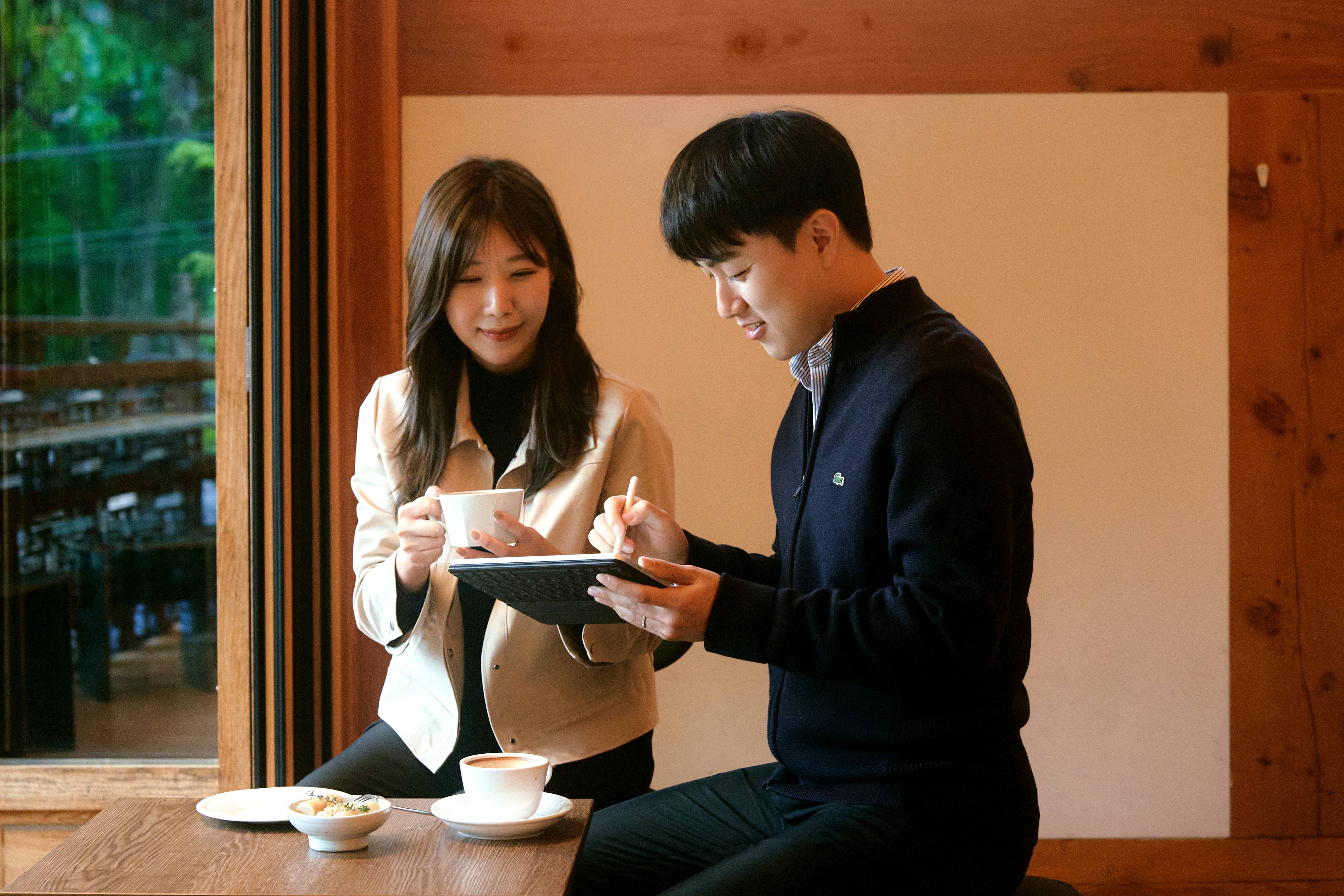This website uses cookies so that we can provide you with the best user experience possible. Cookie information is stored in your browser and performs functions such as recognising you when you return to our website and helping our team to understand which sections of the website you find most interesting and useful.
- Suggested keywords
- #Aisaengkag # FLAMECHECK # EPOCOAT
- PRODUCT14 Types
- Home
- Culture
- ChemiXChemi
Discovering the captivating charms of fencing

The contrast of elegance and power
makes fencing so captivating to its practitioners
Fencing is not a sport most people have experienced. The chosen lucky few from Samhwa have decided to give it a try with a “can-do” spirit. Here’s a summary of the passionate and exciting day they had learning the rhythmic and elegant fencing moves.Park Cheol-hee and Shin Yeong-gyun, both section managers at Samhwa, were joined by colleagues Choi Chang-pyo, another section manager, and Lee Chan-mi, a junior researcher, at Eagle Fencing Club in Songpa-gu, Seoul, to learn the exotic sport for the first time. Fencing was considered one of the five arts that members of European nobility were expected to master back in the 17th century, along with marksmanship, horseback riding, music, and dancing. All the terms used in the sport are French as France is where the modern rules of fencing were established. Fencing is gaining growing attention and popularity in Korea, thanks to the excellent performances of Korean fencing athletes in global competitions and also for the fact that the sport engages all the major muscles of the body and is therefore great exercise.

Fast as a bullet, light as a butterfly: Fente!
After doing some warm-up exercises, the people from Samhwa grabbed the practice swords and began to learn the basics of fencing. Given the noble origins of the sport, etiquette is quintessential to every game. The first thing they learned, therefore, was how to greet their sparring partners properly. You spread your feet in a perpendicular direction and lower your sword below your knee, keeping your arms drawn downward for attention. You then bring the sword to the tip of your nose to salute the opponent (salut). You then go en garde, which involves putting one foot slightly forward and bending your knee. It’s crucial to maintain the core of your body engaged while en garde so that you don’t lose balance. The Samhwa people then learned how to step forward and backward repeatedly on the metallic piste, as rapid footsteps are indispensable to attack and defense in fencing. Moving forward is known as a marche and retreating back is called romper. Fente is perhaps the most dramatic of the moves on the piste as it involves lunging at your opponent with your sword pointing forward. The ability to perform fente at the right moment in time is crucial to your chances of winning. Battement is hitting the opponent’s sword with yours in getting ready to launch an attack. Parade involves using your sword to parry the opponent’s attempt to fente. The trainees from Samhwa had an intense session of practicing techniques for both offence and defense.
“The sword is the part that grabs our attention when we see a fencing athlete launch an attack, but almost all the moves, whether offence or defense, require hard footwork. Since we have to keep our center of gravity low in all positions, I felt my thigh muscles tighten even though I had been doing this for only a short while.” As Choi said this, Park and Shin nodded in complete agreement. Beads of sweat ran down their faces. Lee, who has been practicing kendo for seven years, likewise added that fencing really worked muscles in her thighs and back. Despite the intensity of the workout, everyone was thoroughly enjoying their time.

Fierce battles not just of physical stamina, but also wits
Having practiced the basics, the Samhwa people set out to do some actual sparring. There are three types of fencing matches, depending on the types of sword used and the body parts that need to be targeted for scoring: fleuret, epée, and sabre. The fleuret matches they engaged in today involve using the most flexible type of sword, which can be used only to jab at the opponent’s torso for scoring. Shin and Choi, both confidently taking on the challenge, wore specially designed jackets and metallic vests on top of their plastic protective equipment and put the metal mesh masks on their faces. Whoever was the first to score three points in one minute would win. The breathtaking match began with the referee shouting “Allez!”

Chin! The swords clang and the fencers moved back and forth quickly. After a fierce battle of stamina and wits, Shin was the first to emerge victorious. His colleagues gave him loud applause. The people from Samhwa continued practicing their matches, changing partners after every game. Lee, who drew attention with her formidable posture, managed to beat Shin, the first winner. Park, praised by the instructor as the ace of the group, went on to beat both Choi and Shin in turn.
Park, who loves all sorts of sports and being active, had a big grin on his face at the end of the class, glad to have discovered that fencing was not just a game of physical skill, but also a game of minds. Shin spoke with a sparkle in his eyes: “It felt strange at first, but I had a lot of fun because I could tell that I was improving by the minute.” Choi gave a thumbs-up, adding: “I loved the thrill of launching each successful attack after much focus and hard work.”
The Samhwa fencers intensely used their minds to achieve dramatic wins, making the best use of the rules of the game and striving to maintain their focus until the end. Everyone had at least one victory. Their faces glowed with sweat and pride by the end of the day.
What did you think of fencing?
Park
“I really enjoyed today’s lesson because I thought fencing was something I could only watch in the media. Today’s lesson made me feel all the more confident about the sport. I will definitely be able to enjoy broadcast fencing matches more in the future. I recommend fencing to anyone at Samhwa who would like to take up a new sport in the new year.”
Shin
“What really surprised me while learning to fence was that it was not just a fight of swords, but actually a mind game. It also requires far more physical strength and energy than I thought. I play sports to manage stress, and I find fencing to be a really enjoyable sport I can play. I’d like to learn more if I can.”
Choi
“I’ve always been fascinated by kendo and fencing, and I’m so happy to have been given this opportunity to learn one of them. In fencing, the most important part is to understand the rules of the game perfectly and identify the respective strengths and weaknesses of both yourself and your opponent. That’s the takeaway I got for the new year: Learn my strengths and weaknesses to achieve progress!”
Lee
“I almost completely forgot about the time because I was having so much fun. The matches we did among ourselves really thrilled me because I couldn’t take my eyes off until the very end. I wanted to win so badly, but wasn’t so fortunate in many of the matches I played. In the end, though, I managed to beat Mr. Shin! Thank you, Mr. Shin, for letting me win!”
Discovering the captivating charms of fencing
2024.01.18
The contrast of elegance and power
makes fencing so captivating to its practitioners
Fencing is not a sport most people have experienced. The chosen lucky few from Samhwa have decided to give it a try with a “can-do” spirit. Here’s a summary of the passionate and exciting day they had learning the rhythmic and elegant fencing moves.Park Cheol-hee and Shin Yeong-gyun, both section managers at Samhwa, were joined by colleagues Choi Chang-pyo, another section manager, and Lee Chan-mi, a junior researcher, at Eagle Fencing Club in Songpa-gu, Seoul, to learn the exotic sport for the first time. Fencing was considered one of the five arts that members of European nobility were expected to master back in the 17th century, along with marksmanship, horseback riding, music, and dancing. All the terms used in the sport are French as France is where the modern rules of fencing were established. Fencing is gaining growing attention and popularity in Korea, thanks to the excellent performances of Korean fencing athletes in global competitions and also for the fact that the sport engages all the major muscles of the body and is therefore great exercise.

Fast as a bullet, light as a butterfly: Fente!
After doing some warm-up exercises, the people from Samhwa grabbed the practice swords and began to learn the basics of fencing. Given the noble origins of the sport, etiquette is quintessential to every game. The first thing they learned, therefore, was how to greet their sparring partners properly. You spread your feet in a perpendicular direction and lower your sword below your knee, keeping your arms drawn downward for attention. You then bring the sword to the tip of your nose to salute the opponent (salut). You then go en garde, which involves putting one foot slightly forward and bending your knee. It’s crucial to maintain the core of your body engaged while en garde so that you don’t lose balance. The Samhwa people then learned how to step forward and backward repeatedly on the metallic piste, as rapid footsteps are indispensable to attack and defense in fencing. Moving forward is known as a marche and retreating back is called romper. Fente is perhaps the most dramatic of the moves on the piste as it involves lunging at your opponent with your sword pointing forward. The ability to perform fente at the right moment in time is crucial to your chances of winning. Battement is hitting the opponent’s sword with yours in getting ready to launch an attack. Parade involves using your sword to parry the opponent’s attempt to fente. The trainees from Samhwa had an intense session of practicing techniques for both offence and defense.
“The sword is the part that grabs our attention when we see a fencing athlete launch an attack, but almost all the moves, whether offence or defense, require hard footwork. Since we have to keep our center of gravity low in all positions, I felt my thigh muscles tighten even though I had been doing this for only a short while.” As Choi said this, Park and Shin nodded in complete agreement. Beads of sweat ran down their faces. Lee, who has been practicing kendo for seven years, likewise added that fencing really worked muscles in her thighs and back. Despite the intensity of the workout, everyone was thoroughly enjoying their time.

Fierce battles not just of physical stamina, but also wits
Having practiced the basics, the Samhwa people set out to do some actual sparring. There are three types of fencing matches, depending on the types of sword used and the body parts that need to be targeted for scoring: fleuret, epée, and sabre. The fleuret matches they engaged in today involve using the most flexible type of sword, which can be used only to jab at the opponent’s torso for scoring. Shin and Choi, both confidently taking on the challenge, wore specially designed jackets and metallic vests on top of their plastic protective equipment and put the metal mesh masks on their faces. Whoever was the first to score three points in one minute would win. The breathtaking match began with the referee shouting “Allez!”

Chin! The swords clang and the fencers moved back and forth quickly. After a fierce battle of stamina and wits, Shin was the first to emerge victorious. His colleagues gave him loud applause. The people from Samhwa continued practicing their matches, changing partners after every game. Lee, who drew attention with her formidable posture, managed to beat Shin, the first winner. Park, praised by the instructor as the ace of the group, went on to beat both Choi and Shin in turn.
Park, who loves all sorts of sports and being active, had a big grin on his face at the end of the class, glad to have discovered that fencing was not just a game of physical skill, but also a game of minds. Shin spoke with a sparkle in his eyes: “It felt strange at first, but I had a lot of fun because I could tell that I was improving by the minute.” Choi gave a thumbs-up, adding: “I loved the thrill of launching each successful attack after much focus and hard work.”
The Samhwa fencers intensely used their minds to achieve dramatic wins, making the best use of the rules of the game and striving to maintain their focus until the end. Everyone had at least one victory. Their faces glowed with sweat and pride by the end of the day.
What did you think of fencing?
Park
“I really enjoyed today’s lesson because I thought fencing was something I could only watch in the media. Today’s lesson made me feel all the more confident about the sport. I will definitely be able to enjoy broadcast fencing matches more in the future. I recommend fencing to anyone at Samhwa who would like to take up a new sport in the new year.”
Shin
“What really surprised me while learning to fence was that it was not just a fight of swords, but actually a mind game. It also requires far more physical strength and energy than I thought. I play sports to manage stress, and I find fencing to be a really enjoyable sport I can play. I’d like to learn more if I can.”
Choi
“I’ve always been fascinated by kendo and fencing, and I’m so happy to have been given this opportunity to learn one of them. In fencing, the most important part is to understand the rules of the game perfectly and identify the respective strengths and weaknesses of both yourself and your opponent. That’s the takeaway I got for the new year: Learn my strengths and weaknesses to achieve progress!”
Lee
“I almost completely forgot about the time because I was having so much fun. The matches we did among ourselves really thrilled me because I couldn’t take my eyes off until the very end. I wanted to win so badly, but wasn’t so fortunate in many of the matches I played. In the end, though, I managed to beat Mr. Shin! Thank you, Mr. Shin, for letting me win!”
 Wall paint
친환경 벽지 페인트
Wall paint
친환경 벽지 페인트















